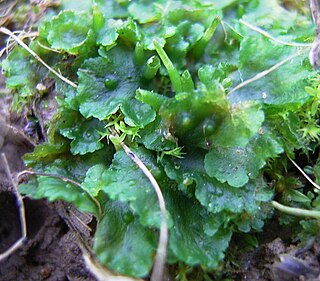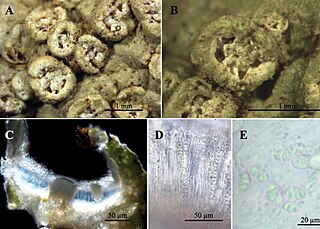
Ceratophyllum is a cosmopolitan genus of flowering plants including four accepted living species in 2016, commonly found in ponds, marshes, and quiet streams in tropical and in temperate regions. It is the only extant genus in the family Ceratophyllaceae, itself the only extant family in the order Ceratophyllales. They are usually called coontails or hornworts, although hornwort is also used for unrelated plants of the division Anthocerotophyta.

Ceratophyllaceae is a cosmopolitan family of flowering plants including one living genus commonly found in ponds, marshes, and quiet streams in tropical and in temperate regions. It is the only extant family in the order Ceratophyllales. Species are commonly called coontails or hornworts, although hornwort is also used for unrelated plants of the division Anthocerotophyta.

Bryophytes are a group of land plants (embryophytes), sometimes treated as a taxonomic division, that contains three groups of non-vascular land plants: the liverworts, hornworts, and mosses. In the strict sense, the division Bryophyta consists of the mosses only. Bryophytes are characteristically limited in size and prefer moist habitats although some species can survive in drier environments. The bryophytes consist of about 20,000 plant species. Bryophytes produce enclosed reproductive structures, but they do not produce flowers or seeds. They reproduce sexually by spores and asexually by fragmentation or the production of gemmae.

The Marchantiophyta are a division of non-vascular land plants commonly referred to as hepatics or liverworts. Like mosses and hornworts, they have a gametophyte-dominant life cycle, in which cells of the plant carry only a single set of genetic information.

Hornworts are a group of non-vascular Embryophytes constituting the division Anthocerotophyta. The common name refers to the elongated horn-like structure, which is the sporophyte. As in mosses and liverworts, hornworts have a gametophyte-dominant life cycle, in which cells of the plant carry only a single set of genetic information; the flattened, green plant body of a hornwort is the gametophyte stage of the plant.

Marchantia quadrata is a species of liverwort, a simple non-flowering plant that grows as a flat, green, leaf-like structure (thallus) typically found on damp rocks and soil along stream banks in the Northern Hemisphere. The species was originally classified in its own genus Preissia due to its distinctive features, including larger spores and lack of the specialised cup-like reproductive structures common in other liverworts, but genetic studies have shown it belongs within the genus Marchantia. Like most liverworts, it reproduces both sexually, through separate male and female plants that produce umbrella-like reproductive structures, and through regeneration from fragments. The species prefers slightly drier habitats than its relatives and shows significant genetic variation across its range, suggesting it may comprise several distinct but closely related species.

Dendroceros is a genus of hornworts in the family Dendrocerotaceae. The genus contains about 51 species native to tropical and sub-tropical regions of the world.

Phaeoceros is a genus of hornworts in the family Notothyladaceae. The genus is global in its distribution. Its name means 'yellow horn', and refers to the characteristic yellow spores that the plants produce in the horn-shaped sporophyte. The genus Phaeoceros was first recognized in 1951 by Johannes Max Proskauer. The type species is Phaeoceros laevis. The genus is distinguished by having yellow spores, different chloroplast structure, relatively less frilliness of the thallus when compared to Anthoceros, and a relative lack of internal cavities in Phaeoceros.
Notothylas is a genus of hornworts in the family Notothyladaceae. The genus is found globally, but is usually overlooked. It is the smallest of all the hornworts, with a yellow-green gametophyte thallus that is seldom more than a centimeter in diameter, and usually much smaller.

Anthoceros is a genus of hornworts in the family Anthocerotaceae. It is distributed globally. Species of Anthoceros are characterized by having a small to medium-sized, green thallus that is more or less lobed along the margins.
Folioceros is a genus of hornworts in the family Anthocerotaceae. The genus is common locally in the tropical and subtropical regions of Asia, growing on moist rocks, in fallow fields, and near waterfalls. It has a yellow-green gametophyte thallus that is crispy and translucent, with short branchings that are almost pinnate. Plants are usually less than a centimeter wide and 3 centimeters long. They may be monoicous or dioicous.
Leiosporoceros dussii is the only species in the hornwort genus Leiosporoceros. The species is placed in a separate family, order, and class for being "genetically and morphologically distinct from all other hornwort lineages." Cladistic analysis of genetic data supports a position at the very base of the hornwort clade. Physical characteristics that distinguish the group include unusually small spores that are monolete and unornamented. Additionally, there are unique strands of Nostoc (cyanobacteria) that grow inside the plant parallel with its direction of growth. Unlike other hornworts with symbiotic cyanobacteria that enters through mucilage clefts, the mucilage clefts in Leiosporoceros is only present in young plants and then closes permanently once the cyanobacterial colonies have been established. Also mycorrhiza and pyrenoids are absent. Male plants have been found in Panama.

The Pertusariales are an order of fungi in the class Lecanoromycetes, comprising 8 families, 31 genera, and over 600 species, many of which form lichens. This diverse group is characterized by complex taxonomic history and ongoing phylogenetic revisions. Originally proposed by Maurice Choisy in 1949 and later formally published by the lichenologists David L. Hawksworth and Ove Eriksson in 1986, Pertusariales has undergone significant reclassification due to molecular phylogenetics studies. The order includes well-known genera such as Pertusaria and Ochrolechia, as well as families like Megasporaceae and Icmadophilaceae.

The Anthocerotaceae is the only family of hornworts in the order Anthocerotales. A family of liverworts characterized by irregular or dichotomous lobing or branching, and a gametophyte lacking distinct pores.

The Dendrocerotaceae is the only family of hornworts in the order Dendrocerotales.

Phaeoceros carolinianus is a species of hornwort—a group of simple, non-vascular plants—that is found worldwide in damp, shaded areas. It forms flat, dark green, rosette-shaped patches measuring 10–20 millimeters (mm) in diameter on bare soil and rock surfaces. The plant is characterised by its horn-like spore capsules, which grow 40–60 mm tall, and for producing both male and female reproductive structures on the same plant. These features, along with its unique spore structure, distinguish it from closely related species like P. laevis.
Clandestinotrema portoricense is a rare species of corticolous (bark-dwelling) crustose lichen in the family Graphidaceae. Found in Puerto Rico, it was described as a new species in 2014. It is characterised by its white, slightly shiny thallus that can span several centimetres in diameter, and its rounded ascomata that are immersed in the thallus. Unlike most of its genus counterparts, C. portoricense possesses septated (partitioned) spores and a carbonised (blackened) excipulum and columella, effectively distinguishing it from similar species.
Compositrema isidiofarinosum is a species of corticolous (bark-dwelling) crustose lichen in the family Graphidaceae. This lichen was discovered in Puerto Rico. It flourishes in the shaded understory of the palo Colorado forest in El Yunque National Forest, clinging to the trunks of unidentified trees.
Aspiciliopsis is a genus of lichen-forming fungi in the family Trapeliaceae. It has two species, both of which occur in the Southern Hemisphere.

Glaucotrema is a genus of lichen-forming fungi in the family Graphidaceae. It has five species.










